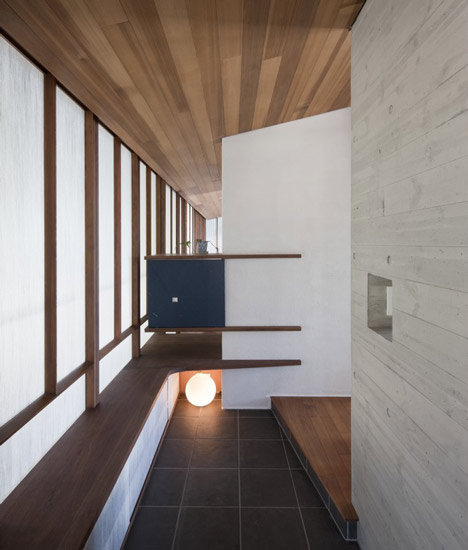Thứ Ba, 31 tháng 1, 2012
Porsche Cayenne Hybrid - Hybrid SUV
Probably not the greenest car on the planet, but Porsche is making an attempt to produce a fuel efficient version of it's extremely thirsty 4 wheel drive behemoth.
Features include: Porsche Traction Management (PTM): permanent all-wheel drive with self-locking center differential, aut. limited-slip differential (ABD) and traction-slip control (ASR), variable rear torque split
manual gear shift or Automatic 8-speed Tiptronic S with Auto start/stop function and gearshift controls on steering wheel
Stats:
279 kW (380 hp) at 5,500 rpm
0-100 km/h (62 mph) in 6.5 s
Top speed: 242 km/h (150 mph)
Combined: 8.2 l/100 km (34.4 mpg)*
CO2 emissions: 193 g/km*
£60,506 (GBP)
Ferrari 599 Hybrid - Kers Hybrid
Ferrari's are normally red, but when they're not they always seems to get themselves plastered in some hideous Look-at-me paint scheme and this 599 hybrid is not one to break that rule.
One of the stars of the 2010 Geneva Motor show and a token effort to address their environmental impact.
Called HY-KERS, the hybrid two-seater uses Ferrari's Formula One Kinetic Energy Recovery System (KERS) to recover the braking and decelerating energy in a state-of-the-art lithium-ion battery.
That electrical energy is converted into about 650 volts, which gives an additional 100 horsepower that is used to supplement the acceleration of the six-litre V12 petrol engine and also run the engine's air conditioning and power-steering pumps.
The HY-KERS remains strictly an experimental vehicle currently, Favaretto Fabrizio, a Ferrari engineer says that it is capable of improving the 15.8mpg fuel consumption and reducing the 415g/km carbon dioxide emissions by up to a third in each case.
It would also monumentally expensive (with the emphasis on mentally!), almost doubling the £207,075 list price of the 205mph 599 GTB Fiorano, and adding 220lb of unsprung weight. Ferrari wants to have the system in production within five years at a far more affordable price and a lighter weight.
Thứ Hai, 30 tháng 1, 2012
What we carry in our PFDs
 |
| What's inside each of our pockets: Sharon (left) and Alec (right). |
You can read about what they told us in the Summer/Fall 2011 issue of Adventure Kayak Magazine. What we carry depends considerably on where we are going and what we are doing. But here's what we nearly always carry in and on our PFDs. (We might add items in certain situations.)
- VHF radio
- waterproof camera
- whistle
- compass
- white light
- strobe
- knife
- snack
- sunscreen
- lip balm
- grease pencil
- very small first aid kit
- very small boat repair kit
- watch
Alec: back-up reading glasses, hair ties.
Sharon: nose clips.
 |
| View number two, with everything spread out. |
We were curious what our kit weighed, so we put it on a scale.
 |
| Alec's kit weighs two pounds (32 oz.), without the plate. |
Carrying more kit does make a PFD heavier and bulkier, which is hard on your body, diminishes flexibility, weighs you down and makes it harder to self-rescue. Those are safety considerations. But needing something you can't access is also problematic.
Like everything else, there aren't any cut-and-dried answers. It's a judgment call. But it's a good idea to reconsider what you're carrying each time you go out and adjust it for the expected situation.
So what do you carry in and on your PFD?
A Legend Passes On
Each of the books mentioned are among the most interesting and captivating paddling-related books that I own. If you read Paddle to the Arctic, you really need to read Jason's account (a rebuttal of sorts) as well.
Had I ever met Don in person, I am not sure that we would have gotten along. However, despite his quirks and foibles (or more likely, because of them), it cannot be denied that Don was an amazing man. His determination and ambition meant that he accomplished in his lifetime what very few would ever be able to undertake let alone complete. He made the paddling world a more interesting and exciting place, and I thank him for allowing me to experience his adventures vicariously through his books.
Here is the link to the Winnipeg Free Press article about Don's death.
Edit: Here is a link to an article from Canoe & Kayak Magazine, it's a good one.
Volvo XC60 - Plug-in Hybrid Petrol/Electric
Volvo the Swedish car maker famous for it's safety features has been keen to emphasize – surprise – the safety of its plug-in vehicles at recent auto shows. At the Detroit Auto Show, Volvo has shown off the XC60 Plug-In Gasoline Hybrid Concept.
Because this concept is headed to the U.S. and Chinese markets – in a different guise and with a lot of changes – within "a couple of years." Likely to mean something like 2014-2015. Volvo's first PHEV here could be an XC60 model, or perhaps an S60, said Volvo CEO and President Stefan Jacoby.
Here are the numbers: a 35-mile all-electric range, a recharging time of just 3.5 hours from a 220V outlet (7.5 hours from a more common 110V). Volvo estimates U.S. fuel economy of 105 MPGe and 50 mpg when the battery runs dry. 0-60 is reached in 5.8 seconds on the way to a 130-mph top speed. Oh, and there is an eight speed auto transmission.
Gasoline is burned in a 2.0-liter four-cylinder engine that is turbocharged and direct-injected and has stop-start technology. This 280-horsepower powerplant moves the front wheels, and a 70-hp electric motor propels the back wheels (this is known as a through-the-road hybrid). The XC60 PHEV has a 12-kWh lithium-ion battery, but just 66 percent of that (8 kWh) is used. The driver can select three modes – Pure, Hybrid and Power – depending on which type of fuel economy and performance is desired. Details of this technology can be found after the jump, and images of the XC60 test bed are available in our galleries.
Chủ Nhật, 29 tháng 1, 2012
iOS 的 photos app....
竟然無法全選.........
超級登登登登愣............
由於我用ipod抓了一堆桌布
copy到電腦就想刪除~~~~我是用ifunbox複製~~~再刪除
誰知道ipod裡面的圖竟然還在.......
但是是cache起來的縮圖
0rz
重點是我要刪除的時候竟然沒有select all的選項
超想哭XD
222張圖真的要我一個一個點才可以刪除......

點沒20個就快瘋了XD
我覺得iOS沒有Android的menu鍵真的輸蠻大的
用過比較起來~~~~真的差很多
像Android的QuickPic menu鍵一按就一堆功能可以用~~
超方便

最後我刪除的方法是~~~
進我的電腦點ipod進去刪除圖片
竟然還要透過電腦......燈愣
reference
http://appotography.com/2011/05/02/delete-photos-iphone/
Method 3: Windows 7 – Connect your iPhone to your computer, and access the photos directly
Simply put, use your iPhone like an external HDD.
On Windows 7 (should work also on Vista):
1. Connect the iPhone to your computer.
2. Go to My Computer, and you should see the iPhone device icon.
3. Double click on the icon, and you should see your photos directory.
4. You can now delete or do whatever you want with the photos, as if they were on your computer HDD.
Lexus LF-FC - Hybrid Concept Car
Buy 2000 Litre Rectangle Poly Water Tank - RT2000PWTV by Poly Water
Underground Rainwater Tanks | Concrete Tanks
Rainwater Tanks & Water Pumps Prices Melbourne Victoria | Kerrimuir Rainwater Tank Accessories Prices | Slimline Water Tanks

.
Capacity: 10,000 litres
Diameter: 2600mm
Height: 2100mm
Warranty: 10 years
Colours available: Standard Colorbond Colours
Thứ Bảy, 28 tháng 1, 2012
On mass and aerodynamics
I calculated the total trip time for a 5 km trip and varied the number of starts. In the next diagram you find the total trip time and the maximum speed for different vehicles. The coefficient of rolling resistance was held constant at 0.005. The QuestSL is a Quest with the mass of an MTB. For the calculation of the plywood velomobile I estimated the effective area to be equal to that of the Versatile. The mass of the Plywood Velomobile was very optimistic chosen to be 18 kg (The current proto is 23 kg).
I assumed a cyclist that delivers 75 W power. At that level the MTB would reach ~20 km/h which is more that the most of us do... We can conclude that at 7 starts in 5 km the Quest and the Plywood Velomobile perform equal. The mass reduction compensates for the compromised aerodynamic quality. At an increased cyclist power the break even point moves to the right. 7 starts in a 5 km trip is quite high but not unrealistic for an urban trip.
All in all we can conclude the most apparent difference exists between the MTB and the other vehicles. The differences between the velomobiles are small. It would be interesting to see what happens when a small slope is taken into account. Another interesting thing is recuperative breaking and start assist.
On second thougth: After a 5 km trip in a Quest with one start only the total work done is 48.2 kJ. The Quest reaches a maximal speed of ~42 km/h after 3.5 minutes. The kinetic energy of the vehicle and rider at 42 km/h is ~7 kJ. Now it becomes very clear what happens when we have to stop and accelerate again: we loose the kinetic energy of 7 kJ which is 7/48=15 % of the energy needed with one start only. Would we have to stop 7 times our energy usage more than doubles ! The MTB uses 104 kJ for the 5 km trip with one start only. His kinetic energy reaches 2 kJ only (2/104= ~ 2%). An extra stop doesn't bother him to much...
Depending on the number of starts in our trip, recuperative breaking and start assist would give a significant increase in performance of the Quest...
Remark: decreasing the mass of the velomobile is not helping much as it is dominated by de rider.
In a slightly different universe, for motorcycle journalists...
Thứ Sáu, 27 tháng 1, 2012
Product review: Kokatat MsFit Tour and Ronin Pro PFDs
 |
| Nothing lasts forever, not even a well-made PFD. |
But some things haven't changed. Kokatat still offers terrific gear that's made in the US and backed by excellent customer service. And the MsFit Tour is still the gold standard among PFDs--another observation we made while researching our article, "The Right Stuff." So we decided to try out the Ronin Pro, an attractive vest with only one big pocket because it is designed for whitewater paddlers, and the new MsFit Tour.
 |
| The new Ronin Pro (left) and MsFit Tour (right). |
 |
| The new MsFit Tour features a clever pouch above the lash tab so a knife can be tucked in. |
 |
| The Ronin Pro features exceptionally large cut-outs around the arms. |
 |
| Alec in the Ronin Pro. A paddler with a short torso fill find it especially bulky over the stomach. |
A single pocket sounded like an attractive feature now that we carry less kit, but Alec discovered that he was always rooting around in it to find what he needed. Having three pockets, even if they aren't full, is better for staying organized. And there was no place on the Ronin to carry a VHF radio.
 |
| The MsFit has ample room in the two side pockets for more than enough gear, a designated radio pocket, and a knife pouch. (No, that's not the knife we'd actually carry.) |
Some day, we hope someone will figure out a way to add buoyancy without bulk. Or perhaps over time we'll discover that we need to carry even less kit, or that PFDs need less foam. Until then, the MsFit seems to offers an excellent combination of fit, adjustability, workmanship, pocket configuration and other features for sea kayakers. Sometimes, like Dorothy, you go out looking for your heart's desire only to find that you had it in your own back yard.
Thứ Năm, 26 tháng 1, 2012
What actual rocket scientists think about e-moto racing
Electric Racing
The Isle of Man TT Zero is an example of a new breed of “zero emission” races. The aim of these races is to spur innovation that will reduce the environmental impact of consumer vehicles. Racing has historically been a catalyst for innovation, particularly in the early years of motorcycles and automobiles [8]. New concepts were tested on the track, and the desire to win drove companies to produce superior technology. Consumer demand for better performance motivated companies to transfer the technology from the race track to the mass market.
The fundamental question is whether or not zero emission racing will yield the desired outcome. With the goal of contributing to the success of zero emission racing, this section outlines a set of guidelines for designing zero emission races that will yield relevant innovation. In this paper innovation is defined as the act of generating a product or service that (1) reduces the environmental impact of vehicles and (2) consumers want to purchase.
Drive technology
Many diverse participants, including inventors, academia, and corporate research labs, contribute to generating and developing innovative ideas. Consumer-focused companies choose relevant developments, refine them, and promote them to the consumer market. Identifying which ideas will succeed is a challenge facing all vehicle companies. Resources are often not available to invest in multiple emerging technologies. For example, it is costly for an automobile company to invest in batteries, fuel cells, and super capacitors simultaneously. Racing competitions should be structured to accelerate the transition from ideas to mass production and simultaneously facilitate the development of multiple technologies.
Provide valued entertainment
Any repeated event that the public finds entertaining will draw a large number of spectators both in person and through the media (e.g. internet, TV, etc.). Spectators and media drive advertising, which creates an influx of funds through team, rider and event sponsorship. These funds help finance the teams, who in turn develop the technology. Thus, valued entertainment is drawing in extra research and development funds that would otherwise not be available for that purpose (Figure 24). For example, an energy drink manufacturer might be indirectly funding battery research. This could translate into millions of dollars spent on zero emission innovation [9].
The influx of available sponsorship also reduces the risk that the team with the most personal wealth will win. In other words, sponsorships are typically chosen based on which team is likely to win; if the teams generating the most innovative vehicles are more likely to win, these teams would be rewarded through sponsorship funds to develop even better technology.
 |
| Figure 24: Valued entertainment can produce millions of dollars in research and development funds. |
Gasoline vehicle racing has evolved dramatically over the last 100 years. Because of this, caution should be used when copying a modern gasoline race with a zero emission equivalent. Zero emission racing might require a different approach, and lessons may be learned from looking back into the beginnings of gasoline racing.
Patience will also be required when directly comparing modern gasoline and zero emission racing. It is easy to forget that it took decades for gasoline engines to make dramatic improvements. For example, it took 50 years for the first gasoline motorcycle to reach a 100 mph average lap at the TT. The electric motorcycles will likely reach the same milestone within 5 years.
Utilize the power of regulation
Regulations should be used as the fundamental tool to engineer a race for a desired outcome. For example, assume that consumers want to refuel their vehicle quickly; if winning a zero emission race is dependent on fast refueling, then the regulations are successfully guiding development. A successful racing innovation platform must focus on technology relevant to the consumer market.
Inspire consumer demand
It is critical that the races inspire consumers to purchase the technology that is found superior on the race track. Otherwise, true innovation will not be achieved through racing, and the objective of reducing the environmental impact of vehicles will not be achieved. One way this can be accomplished is through styling, and ensuring that the race vehicle has brand identity. For example, a motorcycle company should use styling that is distinct and that connects their race vehicle to their commercially available vehicles.
Secondly, inspiration can be found through education. The race should strive to inform the consumer of the environmental affects and implications of the various technologies.
Finally, races can inspire consumer demand by building confidence in new technologies. For example, racing could prove that rapid charging is feasible, which might convince the skeptical consumer that the technology will satisfy their needs.
Call for R&D Projects - format
- it is about steel or any other metal material
- the quality of the text and picture is good
- the content is in coherence with the themes of the conference
To BIM or Not to BIM?
This is an extract from Architects Journal from the 15/12/11, this article looked at trends in design & construction for the UK going into 2012…hopefully AJ won’t mind me highlighting the comment about Revit. :-)
Dude! Where’s my Nodes?
Spotted this one yesterday. In Vasari, if you divide a surface & select the divided surface with a view to changing the Surface Representation, there is no arrow to the Surface Representation options dialogue.This is Vasari…. see..no arrow? No dialogue…no Nodes… :-(
This is the same thing in Revit 2012….arrow to access the Surface Representation options.
I thought I was going mad! Fortunately Zach K. put my mind at rest & confirmed it as an interface bug. The arrow is there, see the image below, but its hidden at the end!
The Tango T600 - Electric Commuter Supercar!
Thứ Tư, 25 tháng 1, 2012
2012 Chevrolet Camaro ZL1










http://www.autoblog.com/2012/01/24/2012-chevrolet-camaro-zl1-first-drive-review/
Stair safety -rise and going

In the BCA, riser and going dimensions in buildings are given as:
| Riser (R) | Going (G) | Quantity (2R+G) | ||||
| Min | Max | Min | Max | Min | Max | |
| Public | 115 | 190 | 250 | 355 | 550 | 700 |
| Private* | 115 | 190 | 240 | 355 | 550 | 700 |






















